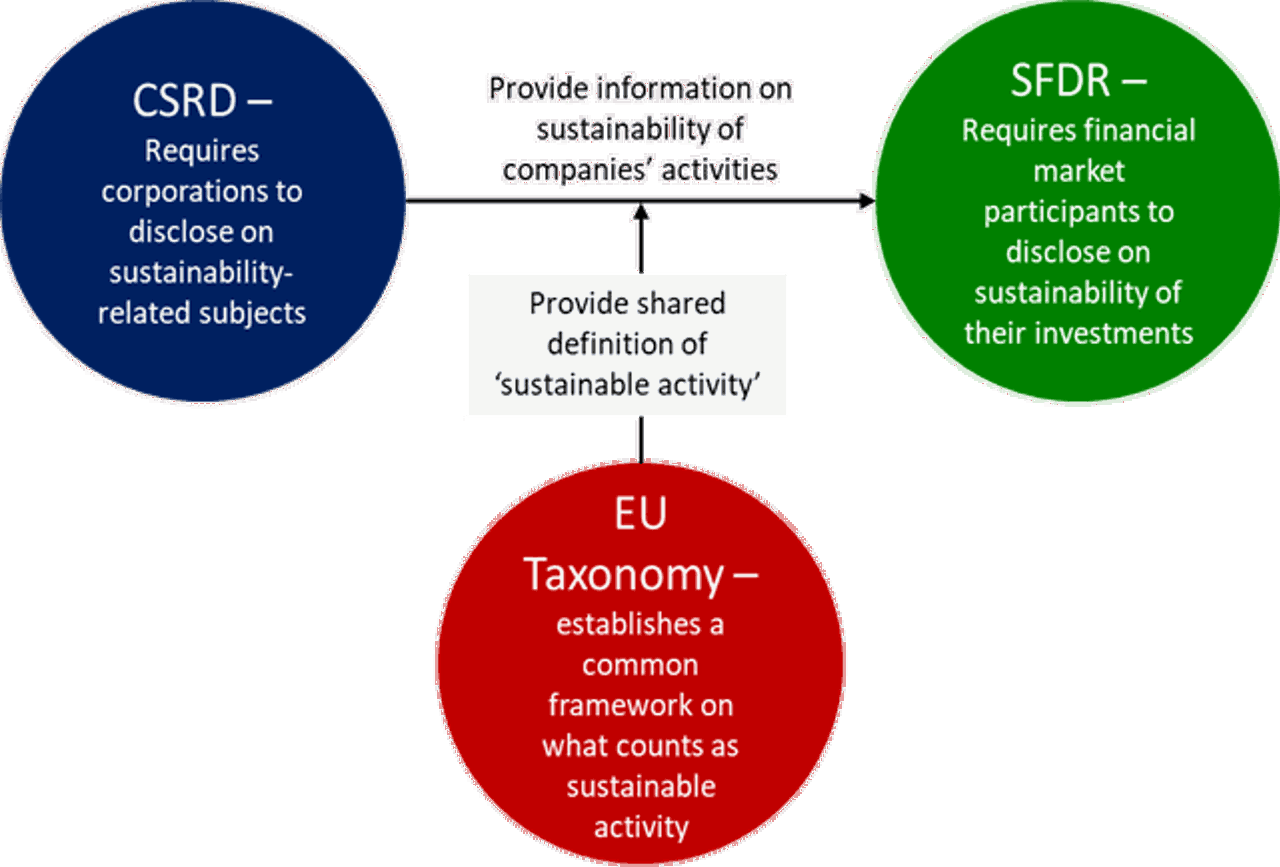This latest revision of the proposal introduces significant relief for all companies and even greater relief for smaller companies (those with fewer than 750 employees) by making some previously mandatory reporting aspects voluntary. Given that the CSRD is an essential part of the sustainable finance package, this latest draft can be seen to weaken its stringency and to increase the difficulty for asset managers to access data. However, it also presents an opportunity for companies and investors to set themselves apart: some will adhere strictly to compliance, others will embrace greater ambition through voluntary disclosures.
What is the CSRD?
The Corporate Sustainability Reporting Directive (“CSRD”) is an EU approved in December 2022, that requires listed and/or large companies to disclose on material impacts, risks and opportunities arising from social and environmental issues, as well as on how their own activities impact people and the environment. According to the EU official statement, the aim is to allow stakeholders, such as investors, consumers, and local communities to evaluate the sustainability performance of a company. The first companies will have to apply the new rules in the financial year 2024, for reports published in 2025.
The CSRD has two components:
- The main body of the law (DIRECTIVE (EU) 2022/2464 OF THE EUROPEAN PARLIAMENT AND OF THE COUNCIL of 14 December 2022), which is an amendment to the Non-financial Reporting Directive (NFRD), the predecessor of the CSRD.
- The reporting requirements developed in a draft version, called the European Sustainability Reporting Standards (ESRS): a set of 12 standards including General requirements (ESRS 1) and General disclosures (ESRS 2) as well as 10 Topical Standards which refer to specific Environmental, Social and Governance topics.
What do the recent changes to the CSRD mean?
Amendment: All topics subject to materiality assessment
Description: Whereas in earlier versions companies had to always disclose on certain topics, e.g., Climate Change (ESRS E1), 9 topics on own workforce (ESRS S1) and governance (ESRS G1), the new draft makes all topics subject to a materiality assessment.
Implication for companies: Companies will have to focus heavily on establishing a solid methodology to produce their materiality assessment.
Implications for stakeholders: Certain key information only released when material, reducing the data available to financial market participants, in particular Climate Change.
Other considerations: Lack of consistency in double materiality assessment methodology amongst peers can lead to inconsistency in topics disclosed.
Amendment: Phase-ins
Description: New phase-ins in addition to the ones previously proposed. These new phase-ins include certain exemptions for undertakings with fewer than 750 employees, and apply, depending on the topic, to the first 3 years.
Implication for companies: The relief, if applicable should be carefully analysed and considered by companies who want to be sustainability leaders. In particular the omission of scope 3 GHG for companies below 750 employees.
Implications for stakeholders: Uncertainty as to when the financial market participants might access key sustainability information according to their sustainability positioning, in particular with regards to the SFDR.
Other considerations: Differentiation of sustainability front-runners vs. laggards. We will see sustainability high-performers outpacing their peers, positioning sustainability as a competitive advantage.
Amendment: Voluntary data points
Description: Several mandatory data points are converted into voluntary. For instance, biodiversity transition plans and explanations for not considering a sustainability topic as material are now voluntary instead of mandatory.
Implication for companies: Companies have more freedom in deciding whether to disclose certain datapoints. Once more, the relief, if applicable should be carefully analysed and considered by companies who want to be sustainability leaders.
Implications for stakeholders: Uncertainty as to when the financial market participants might access to specific data related to material topics.
Other considerations: Differentiation of sustainability front-runners vs. laggards. We will see sustainability high-performers outpacing its peers, positioning sustainability as a competitive advantage.
Amendment: Additional flexibilities
Description: Additional flexibility for mandatory datapoints, such as financial effects arising from sustainability risks and on engagement with stakeholders, and in the methodology to use for the materiality assessment process.
Implication for companies : Financial effects will be challenging to consider, and companies will have more time to develop methodologies.
Implications for stakeholders: Financial effects is a key information for financial market participants, and the changes introduce additional uncertainty as to when and how this decision-useful information will be released.
Other changes relate to:
- Coherence with EU legal framework
- Interoperability with global standard-setting initiatives
- Editorial and presentational modifications
Our view on the latest amendments
The amendments to the CSRD bring about a more permissive stance, granting companies increased flexibility in deciding which information they consider essential to disclose or exclude. Consequently, these updated amendments can be seen as undermining the effective implementation of the Sustainable Finance Framework since companies can selectively choose what they disclose. We believe that this presents an excellent chance for companies to step forward, become pioneers, and establish a strategy that is resilient and future-proof.
Our concerns with the amendments to the CSRD are the following:
1. Weakening the CSRD weakens the whole sustainable finance package
The CSRD is a fundamental part of the EU package for Sustainable Finance. The objective of this package, itself being part of the EU Green Deal, is to attract private funding to help Europe make the shift to a net-zero economy. It plays a key role in supporting economic growth while reducing pressures on the environment.
The three initiatives in the package, the CSRD, the Sustainable Finance Disclosure Regulation (SFDR) and the EU Taxonomy, are closely intertwined. The SFDR requires financial market participants to provide transparency on the sustainability of financial products. Through this improved transparency it helps financial investors to make more informed choices when directing money towards companies and projects supporting sustainability objectives. The Taxonomy provides a shared definition of economic activities that are considered sustainable.
The SFDR and the CSRD are complementary of each other. Financial market participants can only provide disclosures on the sustainability of their investment if the companies that they invest in are required to publish that information. The chain is therefore only as strong as its weakest link. Any relaxation of the requirements for companies to report can create an additional burden.








